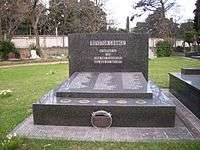STV Royston Grange
The STV Royston Grange was a British cargo liner which was destroyed by fire after a collision in the Rio de la Plata on 11 May 1972. She had been built in 1959 and was owned by the Houlder Line.
| History | |
|---|---|
| Name: | Royston Grange |
| Port of registry: |
|
| Builder: | Hawthorn, Leslie |
| Yard number: | 736 |
| Launched: | 23 June 1959 |
| Completed: | December 1959 |
| Out of service: | 11 May 1972 |
| Identification: | IMO number: 5301502 |
| General characteristics | |
| Tonnage: | 10,385 GRT |
| Propulsion: | 1 x steam turbine |
| Speed: | 16 knots (30 km/h) |
Disaster
The 7,113 ton Royston Grange, carrying 61 crew, 12 passengers (including six women and a five-year-old child), and an Argentinian harbour pilot, was bound from Buenos Aires to London with a cargo of chilled and frozen beef and butter. As she traversed the Punta Indio Channel, 35 miles from Montevideo, Uruguay, in dense fog at 5.40 a.m. she collided with the Liberian-registered tanker Tien Chee, carrying 20,000 tons of crude oil. The Tien Chee immediately burst into flames and a series of explosions rapidly carried the flames to the Royston Grange, which burned particularly hot due to the cargo of butter and the oil escaping from the Tien Chee. Most of the crew and passengers were asleep. Although the Royston Grange did not sink, every person on board was killed in the fire, most of them probably by carbon monoxide fumes emanating from the refrigeration tanks, which burst in the collision.[1]
The Tien Chee subsequently ran aground, blocking all traffic in and out of the port of Buenos Aires. Eight of her 40 crew, who were mostly Chinese, also died, but the remainder along with the Argentinian pilot managed to abandon ship and were picked up by cutters of the Argentine Naval Prefecture.
Aftermath

The remains of the victims, mostly little more than ashes and charred bones (much of the flesh having been stripped from the bones by the hoses used by Uruguayan tugs to put out the fire), were buried in six urns in two communal graves in The British Cemetery Montevideo on 20 May 1972 in the presence of 130 relatives who had been flown out to Uruguay by the ship's owners. A memorial service was held at All Hallows-by-the-Tower in London on 8 June.
The report of the Liberian enquiry into the disaster concluded that the master and pilot of the Tien Chee, in an attempt to get enough water for her deep draught, had probably been navigating too far to the south of the channel and had pushed the Royston Grange onto the shelf that bordered it. The British ship had bounced off and into the tanker. The officers of the Royston Grange, it concluded, were probably not to blame, although there may have been some human error in attempting to avoid the collision. The master and pilot of the Tien Chee probably should not have entered the channel in the first place in the tidal conditions prevailing at the time. The report also criticised the lack of maintenance of the channel.
The Royston Grange was towed to Montevideo, and then to Spain, where her hulk was scrapped at Barcelona on 20 May 1979.[2] The Tien Chee was also scrapped at Buenos Aires in August 1976.[3]
Notes
- However, the refrigeration system on the Royston Grange was a modern electrical freon system situated in a separate refrigeration room at the starboard side of the engine room. The freon gas was compressed and then cooled and injected into a large evaporation cylinder which then supercooled brine that was circulated through the evaporator. The supercooled brine was pumped at three temperature levels to the various cargo holds where the brine circulated through fan blown radiators to cool the cargo. The ship was also an unusual design in that the bridge section, which contained the navigating officers and passengers accommodation, had no direct connection with the engine room, and was separated by a cargo hold from the aft engineer officers and crew accommodation above the main engine room. It has been suggested that the crew and passengers were actually killed by the initial fierce fire caused by the crude oil leaking from the tanker and igniting after the collision, causing a very sudden high temperature with the fire consuming most of the oxygen. If the freon refrigerant containers and evaporation tanks had burst, it would have needed a very high temperature which would have probably been reached after the death of all persons on board.
- "5301502". Miramar Ship Index. Retrieved 21 December 2009.
- "5086293". Miramar Ship Index. Retrieved 21 December 2009.